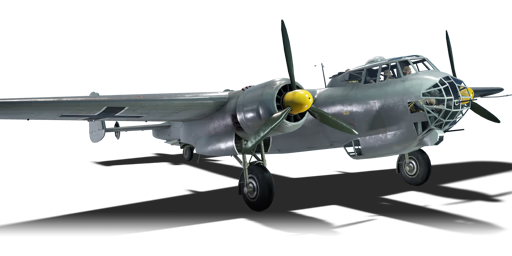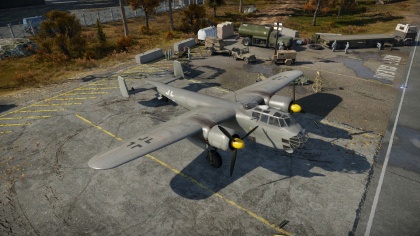Do 217 E-2
Contents
| This page is about the aircraft Do 217 E-2. For other uses, see Do 217 (Family). |
Description
The Do 217 E-2 is a Rank III German medium bomber
with a battle rating of 4.7 (AB), 4.3 (RB), and 4.0 (SB). It was introduced in Update 1.29.
The Dornier Do 217 E-2 is a versatile twin-engined heavy bomber, capable of undertaking level bombing or dive bombing missions, or even strafing or attacking other aircraft with its fixed forward-firing 20 mm cannon.
General info
Flight Performance
Describe how the aircraft behaves in the air. Speed, manoeuvrability, acceleration and allowable loads - these are the most important characteristics of the vehicle.
| Characteristics | |||||||
|---|---|---|---|---|---|---|---|
| Stock | |||||||
| Max Speed (km/h at 5,100 m) |
Max altitude (meters) |
Turn time (seconds) |
Rate of climb (meters/second) |
Take-off run (meters) | |||
| AB | RB | AB | RB | AB | RB | ||
| 463 | 448 | 7500 | 40.2 | 41.1 | 3.8 | 4.8 | 850 |
| Upgraded | |||||||
| Max Speed (km/h at 5,100 m) |
Max altitude (meters) | Turn time (seconds) | Rate of climb (meters/second) |
Take-off run (meters) | |||
| AB | RB | AB | RB | AB | RB | ||
| ? | ? | 7500 | ??.? | ??.? | ??.? | ??.? | 850 |
Details
| Features | ||||
|---|---|---|---|---|
| Combat flap | Take-off flap | Landing flap | Air brakes | Arrestor gear |
| ✓ | ✓ | ✓ | X | X |
| Limits | ||||
|---|---|---|---|---|
| Wing-break speed (km/h) |
Gear limit (km/h) |
Combat flap (km/h) |
Max Static G | |
| + | - | |||
| 0 | 300 | 370 | ~4 | ~3 |
| Optimal velocities | |||
|---|---|---|---|
| Ailerons (km/h) |
Rudder (km/h) |
Elevators (km/h) |
Radiator (km/h) |
| < 290 | < 360 | < 360 | > 250 |
| Compressor (RB/SB) | ||
|---|---|---|
| Setting 1 | ||
| Optimal altitude | 100% Engine power | WEP Engine power |
| 1,000 m | 2,920 hp | 3,046 hp |
Survivability and armour
- 8.5 mm steel - pilot's seat
- 8.5 mm steel - around dorsal gunner
- 8.5 mm steel - aft of ventral gunner
- 5 mm steel - below ventral gunner
Armaments
Offensive armament
The Do 217 E-2 is armed with:
- 1 x 20 mm MG 151 cannon, chin-mounted (250 rpg)
Suspended armament
The Do 217 E-2 can be outfitted with the following ordnance:
- 4 x 250 kg SC250JA bombs
- 28 x 50 kg SC50JA bombs
- 8 x 250 kg SC250JA bombs
- 2 x 250 kg SC250JA bombs + 2 x 500 kg SC500K bombs
- 4 x 500 kg SC500K bombs
- 2 x 1000 kg SC1000L2 bombs
- 4 x 1000 kg SC1000L2 bombs
Defensive armament
The Do 217 E-2 is defended by:
- 1 x 13 mm MG 131 machine gun, rear dorsal turret (500 rpg)
- 1 x 13 mm MG 131 machine gun, ventral turret (1,000 rpg)
- 2 x 7.92 mm MG 15 machine gun, front dorsal turret (500 rpg = 1,000 total)
- 1 x 7.92 mm MG 15 machine gun, nose-turret (500 rpg)
Usage in battles
One of the best bombers in the game, the Do 217 E-2 is capable of reaching over 700 km/h in a dive, making it extremely difficult to intercept when dive bombing from altitude. It has a good climb rate as well, allowing it to reach safer altitudes more easily than other lumbering heavy bombers. Unfortunately, the Do 217 has a rather poor roll rate, which makes it difficult to maneuver, especially when fully loaded.
It is capable of carrying four of the excellent German 1,000 kg bombs, which are more powerful than the equivalent bombs of other nations. While other nations may be able to carry more bombs, they usually carry a larger number of smaller bombs, which is less efficient against bases and airfields. As an added bonus, the Do 217 E-2 is also armed with a fixed forward-firing MG 151/20 cannon. This allows it to surprise fighters attempting to head-on the bomber or even to act as a makeshift bomber interceptor, since it spawns at the same altitude as other bombers in modes with air spawns.
The defensive armament is the only true letdown of the Do 217. The dorsal MG 131 turret is well-placed to cover the top of the bomber from most attacks, although it is not as effective as the American .50 cal. There are a lot of blind spots not covered by the defensive machine guns, most of which are the relatively ineffective 7.92 mm MG 15 anyway.
Manual Engine Control
| MEC elements | ||||||
|---|---|---|---|---|---|---|
| Mixer | Pitch | Radiator | Supercharger | Turbocharger | ||
| Oil | Water | Type | ||||
| Not controllable | Controllable | Not controllable | Controllable | Combined | Not controllable | Not controllable |
Modules
| Tier | Flight performance | Survivability | Weaponry | |||
|---|---|---|---|---|---|---|
| I | Fuselage Repair | Radiator | Turret 7 mm | Turret 13 mm | ||
| II | Compressor | Airframe | New 7 mm MGs (turret) | ITC PVC I | ||
| III | Wings Repair | Engine | Offensive 20 mm | New 13 mm MGs (turret) | ITC PVC II | |
| IV | Engine Injection | Cover | New 20 mm cannons | ETC 2000/XII | ||
Pros and cons
Pros:
- High speed, especially in a dive
- Frame can withstand high speeds
- Excellent bomb load (4 x 1,000 kg)
- Horizontal and dive bombing sights
- 20 mm offensive cannon
- Tail-dragging landing gear (good for high speed landings)
Cons:
- Low maneuverability (especially roll rate at high speeds)
- Very weak stock bombload
- Poor defensive armament
History
The Do 217 was designed to meet the requirement of the Reichsluftfahrtministerium (Air Ministry) for a heavy night bomber or a float-equipped anti-shipping dive bomber. Dornier experimented with the Do 17 with an enlarged fuselage, more powerful engine and almost twice the bomb load of the original Do-17. Dive brakes were fitted under the wings with Daimler-Benz DB601B engines. This design proved under-powered and maneuverable. Instability was a problem, this was soon fixed by installing Handley Page Leading edge slats. The final version used Jumo 211A engines instead of the DB601 and the proposed DB603. Different tail sections were tested out on this version of the Do 217. The final design entered service as the Do 217 E-2. With BMW 801A 14 cylinder radial air-cooled engines. This version of the Do 217 did not have tail mounted dive-brakes. The engine unit was interchangeable with Jumo 211 engines as part of the "Power Egg" concept. The Do 217 normally carrier a crew of four: bomb-aimer/observer/forward gunner, dorsal gunner/radio operator, ventral gunner/flight engineer, and a pilot. The dive brake in the original version was removed.
Media
Excellent additions to the article would be video guides, screenshots from the game, and photos.
See also
Links to the articles on the War Thunder Wiki that you think will be useful for the reader, for example:
- reference to the series of the aircraft;
- links to approximate analogues of other nations and research trees.
External links
Paste links to sources and external resources, such as:
- topic on the official game forum;
- encyclopedia page on the aircraft;
- other literature.
| Germany bombers | |
|---|---|
| Arado | Ar 196 A-3 |
| Blohm & Voss | BV 138 C-1 · BV 238 |
| Dornier | Do 17 E-1 · Do 17 Z-2 · Do 217 E-2 · Do 217 E-4 · Do 217 K-1 · Do 217 M-1 |
| Focke-Wulf | Fw 189 A-1 · Fw 200 C-1 |
| Henschel | Hs 123 A-1 |
| Heinkel | He 111 H-3 · He 111 H-6 · He 111 H-16 · He 115 C-1 · He 177 A-3 · He 177 A-5 |
| Junkers | Ju 87 B-2 · Ju 87 R-2 · Ju 87 R-2 Libya · Ju 87 D-3 · Ju 87 D-5 · Ju 88 A-1 · Ju 88 A-4 · Ju 188 A-2 · Ju 288 C |
| Messerschmitt | Me 264 |
| Savoia-Marchetti | ▀S.M.79 serie 1 · ▀S.M.79 B · ▀S.M.79 serie 4 · ▀S.M.79 serie 8 |
| ▀S.M.79 AS · ▀S.M.79 bis/N · ▀S.M.79 bis/T.M | |
| Trophies | ▀Wellington Mk Ic |





